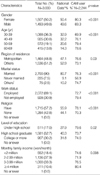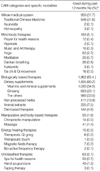1. MacLennan AH, Wilson DH, Taylor AW. Prevalence and cost of alternative medicine in Australia. Lancet. 1996. 347:569–573.

2. Ernst E, White A. The BBC survey of complementary medicine use in the UK. Complement Ther Med. 2000. 8:32–36.

3. Thomas KJ, Nicholl JP, Coleman P. Use and expenditure on complementary medicine in England: a population based survey. Complement Ther Med. 2001. 9:2–11.

4. Yamashita H, Tsukayama H, Sugishita C. Popularity of complementary and alternative medicine in Japan: a telephone survey. Complement Ther Med. 2002. 10:84–93.

5. Barnes PM, Powell-Griner E, McFann K, Nahin RL. Complementary and alternative medicine use among adults: United States, 2002. Adv Data. 2004. 343:1–19.

6. Thomas K, Coleman P. Use of complementary or alternative medicine in a general population in Great Britain. Results from the National Omnibus survey. J Public Health (Oxf). 2004. 26:152–157.

7. Lim MK, Sadarangani P, Chan HL, Heng JY. Complementary and alternative medicine use in multiracial Singapore. Complement Ther Med. 2005. 13:16–24.

8. Hanssen B, Grimsgaard S, Launso L, Fonnebo V, Falkenberg T, Rasmussen NK. Use of complementary and alternative medicine in the Scandinavian countries. Scand J Prim Health Care. 2005. 23:57–62.

9. MacLennan AH, Myers SP, Taylor AW. The continuing use of complementary and alternative medicine in South Australia: costs and beliefs in 2004. Med J Aust. 2006. 184:27–31.

10. Lonroth HL, Ekholm O. Alternative therapies in Denmark--use, users and motives for the use. Ugeskr Laeger. 2006. 168:682–686.
11. Vaskilampi T, Merilainen P, Sinkkonen S. Lewith GT, Aldridge D, editors. The use of alternative treatments in the Finnish adult population. Clinical research methodology for complementary therapies. 1993. London: Hodder & Stoughton;204–229.
12. Millar WJ. Use of alternative health care practitioners by Canadians. Can J Public Health. 1997. 88:154–158.

13. Eisenberg DM, Davis RB, Ettner SL, Appel S, Wilkey S, Van Rompay M, Kessler RC. Trends in alternative medicine use in the United States, 1990-1997: results of a follow-up national survey. JAMA. 1998. 280:1569–1575.
14. MacLennan AH, Wilson DH, Taylor AW. The escalating cost and prevalence of alternative medicine. Prev Med. 2002. 35:166–173.

15. Lee SI, Khang YH, Lee MS, Koo HJ, Kang W, Hong CD. Complementary and alternative medicine in Korea: prevalence, pattern of use, and out-of-pocket expenditures. Korean J Prev Med. 1999. 32:546–555.
17. Pak HA, Oh HS, Song KJ, Kang HS. A study of utilization of alterantive therapies and decison factors among patients with liver diseases. Korean J Health Promot Dis Prev. 2005. 5:212–222.
18. Lee KW, Hong SB, Min KY, Lee SY, Nam M, Kim YS, Ahn CW, Cha BS, Kim KR, Lee HC, Lee KW, Park TS. Resurvey of alternative medicine in Korean type 2 diabetes mellitus after 10 years. J Korean Diabetes Assoc. 2005. 29:231–238.
19. Yoon TH, Park HK, Han DW, Bae SC, Moon OR. Complementary and alternative medicine (CAM) Use and its determining factors among patients with rheumatic disorder in Korea. J Korean Acad Fam Med. 2005. 26:203–210.
20. Chin HW, Jang HS, Jang BS, Jo JH, Kim MB, Oh CK, Kwon KS, Kwon YW. A study on utilization of alternative medicine for patients with atopic dermatitis. Korean J Dermatol. 2005. 43:903–911.
21. Lee KS, Ahn HS, Hwang LI, Lee YS, Koo BH. Utilization of alternative therapies in cancer patients. J Korean Cancer Assoc. 1998. 30:203–213.
22. Lee EI, Shin YC, Lee JH, Kim SD, Kim HJ, Jo MS. Use of complementary and alternative medicine in cancer patients at 7 general hospitals in Seoul. J Korean Public Health Assoc. 2002. 28:225–238.
23. Suh DH, Kang SB, Kim JW, Park NH, Song YS, Kang SB, Lee HP. Utilization of complementary and alternative medicines (CAMs) in women with gynecologic malignancies. Korean J Gynecol Oncol Colposc. 2004. 15:204–212.

24. Chae BJ, Song BJ, Kim SS, Kim SK, Jun KH, Song KY, Chin HM, Kim W, Park CH, Park SM, Lim KW, Kim SN, Jeon HM. Use of complementary and alternative medicine by gastric cancer patients. J Korean Surg Soc. 2007. 72:369–378.




 PDF
PDF ePub
ePub Citation
Citation Print
Print





 XML Download
XML Download